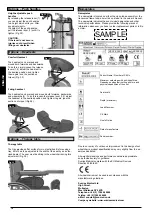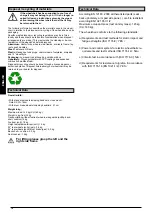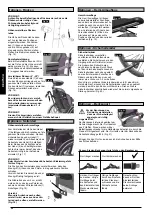
12
Options - Backrest
CAUTION:
When fixing the back make sure that the shell is properly at
-
tached to the guiding hooks
and locked correctly.
Height-adjustable backrest
The height of the backrest can
be set to 3 different positions .
Release and remove the bolts (1),
and move the guiding hooks (2)
to the desired position. Tighten up
the bolts again (Fig. 17).
Trunk support
The trunk support can be adjusted in
angle, depth and height (see fig.18)
It can be swing away by turning the
release lever (1)
Reclining back (0° - 35°)
By pulling lever (1), you can release
the backrest and then move it to the
desired position. On releasing the le
-
ver (1) the backrest will automatically
lock into place
(Fig. 19).
CAUTION:
It is recommended that the reclin-
ing back is used in conjunction
with anti-tip tubes (maximum
ground clearance 3 – 5 cm).
CAUTION:
Never adjust the back angle if the
wheelchair is on a slope.
Options - sideguard
Height.adjustable arnrests
To adjust the height, pull the lever (1)
and push the armrest to the desired
height. Afterwards make sure that
the lever (1) locks back into position.
To remove the sideguard completely,
push the lever (2). When fitting the
sideguard, the lever (2) must also be
pushed. Always make sure that the
sideguard locks into position correctly
in the receiver. (Fig.20)
CAUTION:
There is a danger of trapping your fingers when you adjusting
the armrest height.
The armpad position can be altered by opening the star knob (3)
and moving the pad into the desired position.
Caution: make sure that the star knob is tightened correctly!
To increase the seat width by 2 cm the
inner pad can be removed and/or 2
spacers (1) added (Fig.21).
Caution:
When spacing out the armrest the rear
wheel must be moved out too (Fig.18)
Options – Hemiplegic armrest
Hemiplegic armrest
The hemiplegic armrest can be
adjusted both in length and angle.
You can adjust the length by push
-
ing the armrest after having loos
-
ened the 2 rotary screws (1). To
adjust the angle, open the release
lever (2) and rotate the armrest to
the desired position, then tighten it
again (Fig. 22).
Options – Anti-Tip Tubes
Anti-Tip Tubes
Anti-tip tubes provide additional
safety for inexperienced users when
they are still learning how to operate
their wheelchair. They prevent a
wheelchair from tipping over back
-
wards. By pushing on the release
button, the safety wheels can be set
upwards or removed. There must
always be a gap of 3 - 5 cm between
the wheels and the ground.
You must swing the anti-tips upwards when going up and down
large obstacles (such as a kerb) to prevent them from touching the
ground. Then rotate the safety wheels back down to the normal
position (Fig.23).
Before using your wheelchair
ensure the seat belt is worn
and correctly adjusted
before use.
The lap belt is fitted to the wheelchair
as shown in the illustrations. The seat
belt comprises 2 halves. They are fitted
using the existing seat stay retaining
bolt fitted through the eyelet on the belt. The belt is routed under
the rear of the side panel. (Fig. 24)
Adjust the belt position so buckles are in the centre of the seat.
Adjust lap belt to suit the user’s needs as follows:
To increase the belt
length
To reduce the belt
lenght
Feed free belt
through slide adjust
-
ers and male buckle
to provide more belt
length.
Feed free belt back
through male buckle
and slide adjusters.
Ensure belt is not
looped at male
buckle.
Options – Lap belt
Fig. 21
Fig. 24
Fig. 23
Fig. 22
Fig. 20
Fig. 19
Fig. 18
Fig. 17
1
1
2
1
2
1
3
1
2
1
ENGLISH
Summary of Contents for Breezy Relax2
Page 131: ...131 ...













































